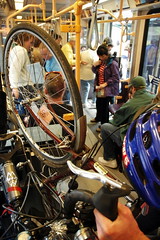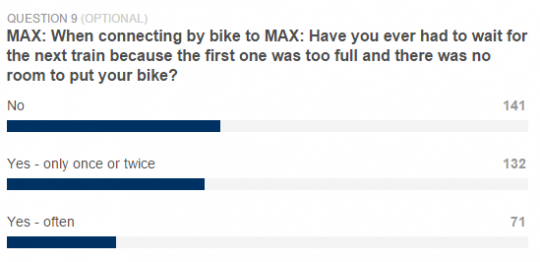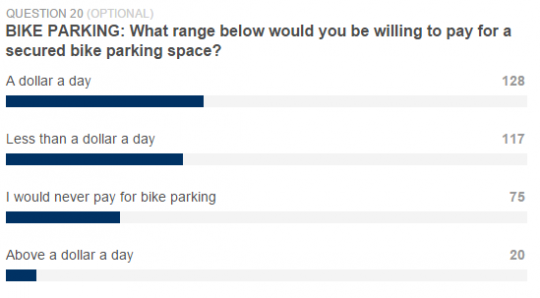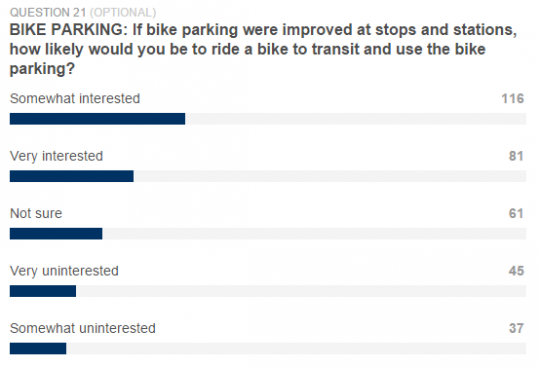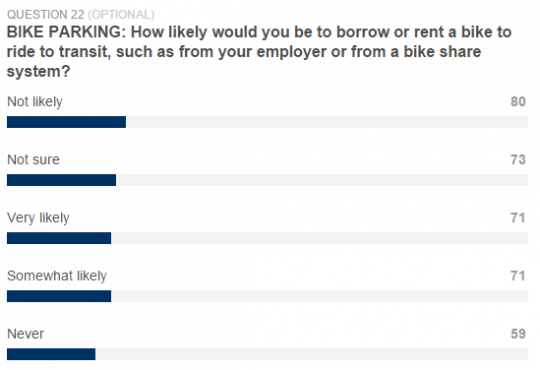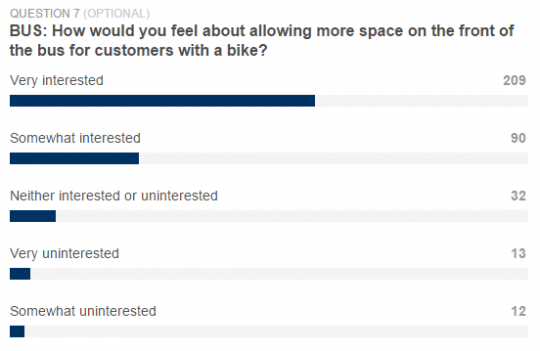Many people who take their bikes on MAX have had to skip a train at least a few times because it’s too full of people.
But park a bike at the station because all the hooks are full? Not so common. Most riders will wheel it on anyway if they can, even if it’ll block other people from boarding down the line.
Those are two findings from an online survey, conducted as part of TriMet’s bike plan, that explored the problem of people trying to take their bikes on MAX and bus but running out of space.
Here’s the question about skipping trains that can’t fit a bike. 21 percent of respondents said this happens to them “often,” and another 38 percent said they’ve done so once or twice:
And here’s the question about whether people would park a bike if all of the train’s four to eight hooks were full. 62 percent of respondents said they were “very unlikely” to do this, and another 13 percent said they were “somewhat unlikely.”
Overcrowded rush-hour MAX trains are a significant problem on TriMet’s busier routes, with the Hillsboro-to-Gresham Blue Line being the most crowded. One solution, of course, would be to run more trains. But train operators cost money, and because of the Pioneer Courthouse Square track crossing and the Steel Bridge bottleneck, the system’s rush-hour capacity is almost maxed out.
So for years, TriMet has been trying to follow the example of many European cities and improve the bike parking near transit stations. It’s built secure pay-to-park bike-and-rides at the Sunset, Beaverton and Gresham Central transit centers plus two stops along the new Orange Line. Another one at the Gateway Transit Center has been long discussed.
It’s always been a little odd that TriMet charges a few cents per hour for people to park their bikes in these while continuing to offer free parking to anyone who arrives by car.
Advertisement
In its survey, TriMet tested the public’s appetite for more paid bike-and-rides by asking what people would be willing to pay for secure bike parking. 78 percent of respondents said they’d be willing to pay something:
And 58 percent of people said that some sort of improved bike parking would make them more likely to “ride a bike to transit and use the bike parking.”
With at least one central-city bike sharing system finally on the way next summer, it’ll be interesting to see whether more people who currently bring their bikes downtown by transit will buy bike-share memberships in order to leave their personal bikes at their home stations. Based on TriMet’s brief description of the service, 40 percent of respondents said they’d be “very” or “somewhat” likely to consider this. But without much public understanding of bike sharing and without knowledge of where bike sharing stations will be available, it’s hard to say how reliable these figures are:
The TriMet survey did have one very clear finding: people who combine bikes and TriMet are big fans of being able to use space at the front of buses to store their bikes.
Bikes and transit are the killer combo for helping people escape car dependence, and TriMet deserves credit for trying to find ways to make them work together. Hopefully the solutions they find to overcrowding will continue to recognize that bikes aren’t a problem to be managed away but rather an asset to capitalize on.
— Michael Andersen, (503) 333-7824 – michael@bikeportland.org

